Dairy products, including milk, cheese, yogurt, and butter, require specialized packaging to maintain their freshness, safety, and nutritional value. The right packaging materials and methods can extend the shelf life of dairy products while protecting them from contamination and spoilage. This article explores various aspects of dairy packaging, including materials used, the best packaging options for milk, methods of packaging milk, and future trends in dairy packaging.
- Food Packaging: What is it? The Role of Packaging in Food Preservation and Safety
- The History of Food Packaging: A Journey Through Time
What Is Dairy Packaging?
Dairy packaging refers to the materials and methods used to package dairy products to ensure they remain fresh, safe, and appealing to consumers. Effective dairy packaging protects products from environmental factors like light, oxygen, and moisture, and often involves innovative designs and materials that cater to the specific needs of different dairy items.
Dairy Packaging Materials
Plastics
Plastics is a packaging product that combines flexibility, strength, lightness, stability, and ease of sterilisation.
- Types:
- Polyethylene (PE)
- Polypropylene (PP)
- Polystyrene (PS)
- Polyethylene Terephthalate (PET): Pigmented PET protects the food from light, which helps protect food flavor against light-induced lipid oxidation.
- High-density polyethylene (HDPE): HDPE bottles are best suitable for storing pasteurized milk
- Advantages:
- Lightweight: Reduces shipping costs and carbon footprint.
- Durable: Provides strong barrier protection against moisture, oxygen, and contaminants.
- Flexible: Can be molded into various shapes and sizes to suit different products.
- Recyclable: Many plastics can be recycled, contributing to environmental sustainability.
- Uses: Milk bottles, yogurt cups, cheese wraps, and butter containers.

Metal
Metal packaging is easy to handle in store, minimizing spoilage and costs. Due to its unbreakable, it reduce the risk of leaking or tearing during transportation, warehousing, on retail shelves or in consumers’ homes.
- Types: Aluminum, tinplate.
- Advantages:
- Excellent Barrier Properties: Protects against light, air, and moisture, extending shelf life.
- Durability: Resistant to physical damage, ensuring the integrity of the product.
- Recyclability: Metal packaging is highly recyclable, reducing environmental impact.
- Uses: Evaporated milk cans, cream cans, and some butter containers.
Cardboard
Paper and board are derived from organic fibers from wood and other biomass sources. Paper is frequently used in combination with coatings, foil, wax, or plastic materials to provide barrier properties and sealability.
Cartons are used to protect and distribute some dairy products, and are, on average, made of (by weight):
- 75% paperboard: a renewable material stemming from responsibly managed forests
- 21% polymers: mostly polyethylene, to prevent leakage
- 4% aluminum: to protect drinks and food from light and oxygen

- Types: Paperboard, corrugated fiberboard.
- Advantages:
- Eco-Friendly: Made from renewable resources and is biodegradable.
- Cost-Effective: Inexpensive to produce and lightweight, reducing shipping costs.
- Versatile: Can be printed with high-quality graphics for branding and marketing.
- Insulation: Provides good thermal insulation, keeping dairy products cool.
- Uses: Milk cartons, yogurt multipacks, and cheese boxes.
Glass
In the dairy industry, glass is used mainly for desserts and fermented milk, and for liquid milk. Glass is 100% recyclable and can be recycled endlessly with no loss in quality or purity.
- Advantages:
- Non-Reactive: Does not interact with the product, preserving its taste and quality.
- Transparency: Allows consumers to see the product, enhancing trust and appeal.
- Reusable and Recyclable: Can be reused multiple times and is 100% recyclable.
- Premium Feel: Often associated with higher-quality products.
- Uses: Milk bottles, glass jars, and specialty dairy product containers.

What Is The Best Packaging Material For Milk?
The best packaging material for milk depends on various factors such as shelf life, distribution, consumer convenience, and environmental impact. Common materials include:
- Plastic (HDPE): Widely used for milk bottles, providing excellent barrier properties, light weight, and ease of transportation.
- Cardboard Cartons: Often lined with plastic or foil to improve barrier properties, popular for both fresh and long-life milk.
- Glass: Offers superior protection and preserves taste but is heavier and more prone to breakage.
What Are The Methods Of Packaging Milk?
Aseptic Packaging
- Involves sterilizing the milk and the packaging separately before combining them in a sterile environment.
- Extends shelf life significantly without refrigeration.
Pasteurization and Cold Packaging
- Milk is pasteurized and then filled into containers that are sealed and stored at refrigerated temperatures.
- Common for fresh milk with a shorter shelf life.
Ultra-High Temperature (UHT) Processing
- Milk is heated to a very high temperature for a short time and then packaged in sterile containers.
- Allows for long shelf life without refrigeration.
Bag-In-Box Packaging
- Utilizes a flexible plastic bag inside a rigid or semi-rigid outer box.
- Suitable for larger quantities of milk, often used in food service settings.
The Future Of Dairy Packaging
The future of dairy packaging is poised to focus on sustainability, innovation, and enhanced consumer convenience. Trends include:
- Sustainable Materials: Increasing use of biodegradable and compostable materials to reduce environmental impact.
- Smart Packaging: Incorporation of sensors and indicators to monitor freshness and provide real-time information to consumers.
- Lightweighting: Reducing the amount of material used in packaging without compromising strength or safety.
- Recyclable and Reusable Packaging: Development of packaging that can be easily recycled or reused, promoting circular economy practices.
Conclusion
Dairy packaging plays a crucial role in maintaining the quality, safety, and shelf life of dairy products. From traditional materials like glass and metal to modern plastics and cardboard, each type has its unique advantages. The methods of packaging milk, such as aseptic packaging and UHT processing, cater to different market needs and consumer preferences. Looking ahead, the dairy packaging industry is moving towards more sustainable, innovative, and consumer-friendly solutions, ensuring that dairy products remain fresh and safe while reducing environmental impact.




